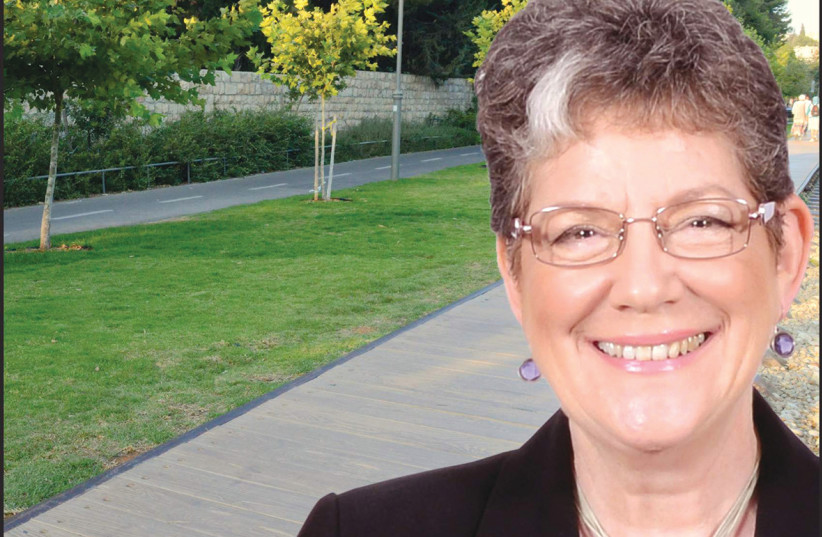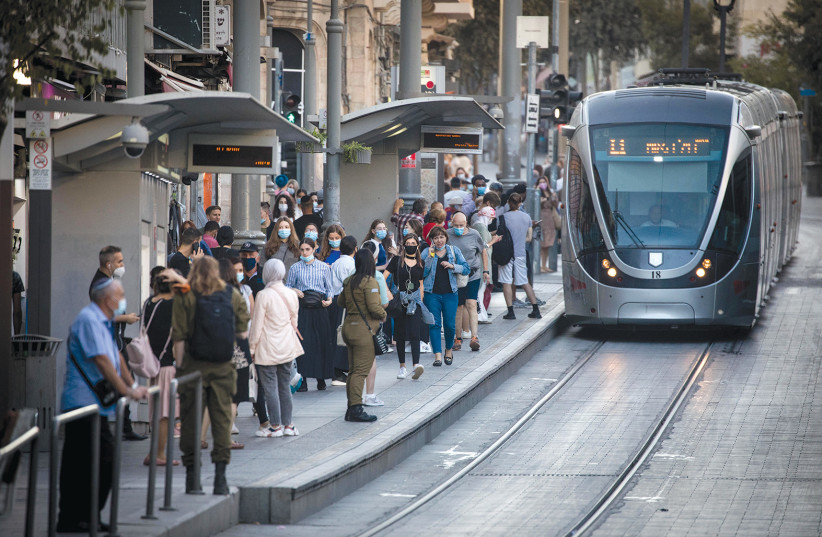Having just returned from the World Urban Forum (WUF) held June 26-30 in Katowice, Poland, former Jerusalem deputy mayor and longtime environmental activist Naomi Tsur says confidently that Jerusalem, despite all its complexities both urban and human, is on the plus side of the urban continuum of world cities in terms of urban planning and sustainability.
A wearer of many hats, Tsur is also the founder and executive chairwoman of the Israel Urban Forum, chairwoman of the Jerusalem Green Fund, and head of the Sustainable Jerusalem Lobby.
The World Urban Forum was established in 2001 under the umbrella of UN Habitat, and meets every two years to confront the challenge of rapid urbanization and its impact on cities, communities, climate change, economies and policies.
National urban forums for each country have been established as well, with Israel one of the 55 countries that did so. The Israel Urban forum is unique in that while the other national forums are under control of the national governments, Israel’s forum is a nonprofit organization that works in conjunction with the government but is independent of it, noted Tsur.
Now it has become apparent that to really address urban issues, individual cities also need to have local urban forums, she added.

While Jerusalem did not have any official representation at the World Urban Forum in Poland, Tel Aviv was represented by the head of its strategic planning department and the head of its regional planning committee, noted Tsur.
Yes, Tsur said, Jerusalem is currently suffering from traffic congestion, construction galore, and planning inequalities between neighborhoods and outright failures, but when she goes downtown – normally by light rail straight from her home, but by bus for the next two months, as construction work on the network of the train lines is carried out until August 22 – she knows that Jerusalem is, excuse the pun, on the right track.
“With comparison to the global field, I think Jerusalem is doing well. I go down to the city center today and the whole area from Mamilla to the Mahaneh Yehuda shuk [outdoor market] is one of the most wonderful city centers in the world,” she said. “Jaffa Road is traffic free, Ben-Yehuda is traffic free, soon King George will be traffic free. The little area at the Davidka Square has benches and trees where people like to sit. It is working.”
“Jaffa Road is traffic free, Ben-Yehuda is traffic free, soon King George will be traffic free. The little area at the Davidka Square has benches and trees where people like to sit. It is working.”
Naomi Tsur
Safra Square, on the other hand, she said, with its large, bare and empty courtyard devoid of trees or benches, is not working.
Public transportation renovations worldwide
Having to take the bus downtown now instead of the light rail is a bit of a hassle, and tacks on travel time, she acknowledged, but she points out that Jerusalem is in good company, with many other cities in the world going through a decade or more of upheaval with public transportation renovations, such as in Paris, which is now nearing the completion of its own 25-year upgrade and renovation project for the Métro system.
While right now the entrance to the city by the Jerusalem International Convention Center looks like a massive jumble of construction, when it is finished the pollution of private cars will be underground, while above ground there will be a network for public transport, people, bicycles and the important trees, she said.
“We just have to go through it,” she said. “Jerusalem is in a very difficult situation transportation-wise at the moment. It is going through a very difficult phase between being a city where you can’t manage without a private car to being a city where you can’t manage with a private car. Many cities go through that, and it is very painful while it is going on. Ultimately, public transport will be the best, though it will be quite a long road until we get there.
“The way people conduct their life in world cities is going to decide how sustainable our world will be,” she emphasized, and that is the reasoning behind the convening of the WUF for cities to discuss shared issues.
So though in Jerusalem it will also take about 10 to 20 years for the whole light rail system to be complete, and there are still many things that can go wrong, as they already have, Tsur said she chooses to look at the good things that are happening in Jerusalem, which are in line with the world trends moving toward urban sustainability, such as the development of a low emission zone for all Jerusalem, which is in the process of being implemented, and which was presented at the Israel pavilion at the World Urban Forum organized by the Construction and Housing Ministry, the Jerusalem Affairs and Heritage Ministry, and the Planning Authority of the Interior Ministry.
“The city has climate plans – the world is talking about the climate crisis, but that conversation has to be at the city level; each city has to address its climate footprint, and the climate plan in Jerusalem involves making sure to protect the city’s nature, planting trees, developing independent sustainable sources of energy,” she said.
On the positive side of Jerusalem moving toward the sustainable city model supported in the WUF, she said, are the urban park areas such as the Gazelle Park and Hamesila Park, and even the construction of the light rail’s Blue Line along 800 meters on Emek Refaim Street, which has been so contentious.
Studies have shown that some 80% of cars on Emek Refaim are on their way to Talpiot, she pointed out. Once the whole light rail system is in place, that will be the more efficient way of getting there, and there will be no need to drive through Emek Refaim, leaving it open to become a more pleasant, less congested neighborhood center, she said.
On the negative side and not in line with the world sustainable goals discussed at the WUF and other international network forums is the level of urban noise in Jerusalem, which is ubiquitous from neighbors partying all night with loudspeakers, cars honking horns unnecessarily and construction work not observing regulations – with soon a petition coming out to bring this to the attention of political candidates who want to run in the next municipal election in a year and a half, she said.

“The psychological damage done to urban communities by unnecessary noise can really be severe. It can eat into you,” she said. “It touches on the whole area of ethics of the environment in a city. It is an ethical issue of needing to think not only about ourselves but about others when we go about our daily lives.”
She also listed on the negative side the construction of high-rise towers away from the light rail routes, such as the Carmit building in the basin of Ein Kerem (and the “suffocating” of the iconic monster slide in the Kiryat Yovel neighborhood by three monstrous high-rise towers) and the attempts of construction of some 5,250 housing units in the area known as “Reches Lavan” (White Ridge) in the Jerusalem Hills in the southwest of the city near the Hadassah-University Medical Center, which would see the destruction of natural springs and wells, as well as the uprooting of some 11,000 trees, which are vital for the absorption of carbon emissions from the city, she said.
Though Mayor Moshe Lion stepped in to protect the area as a national park, realizing the importance of preserving the natural space, and attempts are still being made to stop the project by bringing it to the attention of various public committees, the Interior Ministry and even the prime minister, it may be too late to stop the plan, which was put in motion five years ago and has been approved by the district planning committee, said Tsur.
“This is clearly an anti-climate policy. It is a clash between the need to carry out in Jerusalem a strong climate plan (as discussed in global forums), preserving forest areas, water sources and nature in and around the city, and building plans that haven’t taken that into account at all,” she said.
During the WUF conference some 50 parallel sessions were held throughout the day in five different venues, she said, discussing myriad topics with a great emphasis on the inclusivity of a city as an important quality for sustainability.
“The character of a city is defined by shared public domain. These are questions which were discussed: how these public domains are shared, how inclusive they are, and how they accommodate communities,” she said.
For Jerusalem that means also the services, educational and cultural institutions and opportunities provided both in Arab neighborhoods as well as in the ultra-Orthodox neighborhoods, she said.
“East Jerusalem has been failed consistently since 1967. It is not a question of one administration or another... it is a question of how to function as one city and how to provide development and services,” she said.
As for the ultra-Orthodox communities’ inclusivity, she noted the Romema neighborhood as an example of an active member of the Sustainable Jerusalem Lobby, which has taken a leading role in protecting the 7-8 hectares of open space of the Nahal Romema area that could be made accessible to them as a park, which the neighborhood is entirely lacking with its dense building construction.
Indeed, she said, a main topic of discussion at the WUF was how to make cities green enough and healthy enough to make people want to live in them. In Jerusalem many people are escaping the city from all sectors of the population because of the high cost of housing, she said, something that Israel, as the tiny country it is, can’t afford.
Focus needs to be placed not only on building housing units, but also making sure those housing units are affordable and attracting the kind of people who work and can contribute to the city economy and pay their taxes, by providing pleasant green areas and proper community services in their vicinity, she said.
“Jerusalem is the poorest city in the country and does not punish people who can’t pay city taxes. But no one puts that money back in the coffers. The challenge [for Jerusalem] is not what percentage of one population or the other [there is in the city] but what will be the percentage of residents who can pay their taxes,” said Tsur. “We want to put ingredients into city life that will make the city attractive to those people.” ❖
